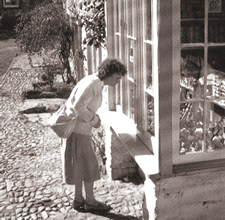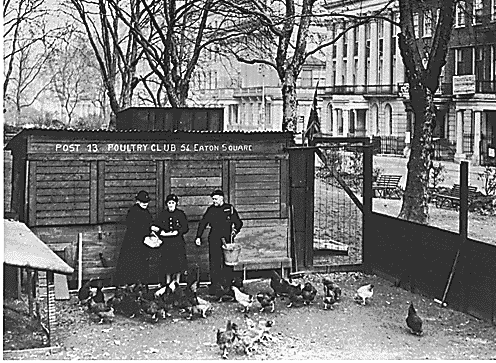Rationing In Britain

British woman peers longingly at meager goods in a shop window just beyond reach because of rationing.

British Family Ration Book

A woman considers her available ration coupons while London shoppers wait their turn at a store

Imported Products from Canada, America & Australia eased the shortage of food
Before the Second World War started Britain imported about 55 million tons of food a year from other countries. Naturally, the Nazi-German government did what they could to disrupt this trade. One of the main methods used by the Nazis was to have their battleships and submarines to hunt down and sink British merchant vessels. With imports of food declining, the British government introduced a system of rationing. This involved every householder registering with their local shops. The shopkeeper was then provided with enough food for his or her registered customers.
In January, 1940, rationing began with bacon, butter and sugar. This was followed by meat, fish, tea, jam, biscuits, breakfast cereals, cheese, eggs, milk and canned fruit. Rationing was a popular method with the British people for dividing the available goods and a poll showed over 60 per cent in favor of this system.
In the summer of 1940 the government established a committee of nutritional experts to advise the War Cabinet on food policy. The committee issued a report claiming that an adult could survive weekly on:
twelve ounces of bread,
a pound of potatoes,
two ounces of oatmeal,
an ounce of fat,
six ounces of vegetables
and six-tenths of a pint of milk,
supplemented by small amounts of either cheese, meat, fish, sugar, eggs and dried fruit.
Other goods such as cigarettes and alcohol were never officially rationed, but were often in dismal supply. Some shopkeepers kept their limited stocks for their favorite customers. This created a great deal of bad feeling and it was not uncommon for shopkeepers to be reported to the Ministry of Food.
Children were treated differently from adults and were entitled to extra foods considered essential for growth, such as milk and eggs. The National Milk Scheme provided one pint of milk for every child under five. Expectant mothers and young children were entitled to free milk if the combined income of parents was less than 40 shillings (approx. eight dollars) a week.
The food rationing system gave people the opportunity to obtain a balanced diet and as a result the health of the nation improved during this period.
People were encouraged to provide their own food. The government's Dig for Victory campaign called for every man and woman to keep an allotment. Lawns and flower-beds were turned into vegetable gardens. Chickens, rabbits, goats and pigs were reared in town gardens.
Clothing was rationed from June, 1941. A points system allowed people to buy one completely new outfit a year. To save fabric, men's trousers were made without cuffs, while women's skirts were short and straight. Women's magazines were packed with handy hints on how, for example, old curtains might be cut up to make a dress. Stockings were in short supply so girls colored their legs with gravy browning. Sometimes a friend would draw a line down the back of their legs with an eyebrow pencil for a seam.
The trade in goods in violation of the official regulations became known as the Black Market. A secret staff at the Ministry of Food investigated attempts by people to deal with black marketers. Parliament passed legislation which enabled the courts to impose fines of up to £500, with or without two years' imprisonment, plus three times the total capital involved in the transaction. Eventually around 900 inspectors were employed to make sure that the statutory orders of the Ministry Food were obeyed by customers, retailers and wholesalers.
Investigators discovered that farmers and small land-holders were the main source of producing foods for the Black Market, largely to the American expeditionary forces.
Poultry Club feeds their charges in an urban location






